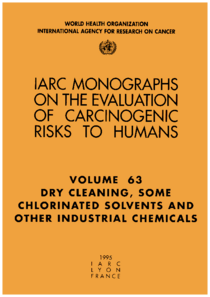Dry cleaning, some chlorinated solvents and other industrial chemicals

International Agency for Research on Cancer, Lyon
IARC - Lyon
1995
551 p.
cancer ; carcinogens ; chemicals ; detergent ; dry cleaning ; solvents
IARC Monographs on the evaluation of carcinogenic risks to humans
63
Chemicals
English
Charts;Index
92-832-1263-0
"Evaluates the carcinogenic risks to humans posed by exposures in the dry cleaning industry, by eight chlorinated solvents and related chemicals, and by an additional group of seven industrial chemicals. Dry cleaning is evaluated in the first and most extensive monograph. Concerning exposures to specific chemicals, tetrachloroethylene is identified as the most commonly used solvent during the last two to three decades. The evaluation also considers exposure to the wide range of chemicals used in the treatment of spots. A review of epidemiological studies on dry cleaning indicates that the risks for cancers at two cites, urinary bladder and oesophagus, may be increased by employment in dry cleaning. The monograph concludes that dry cleaning entails exposures that are possibly carcinogenic to humans. A second group of monographs evaluates selected chlorinated solvents and related chemicals used in dry cleaning, metal cleaning and degreasing, as chemical intermediates, and in the production of insecticides and herbicides. Trichloroethylene, tetrachloroethylene, and 1,2,3-trichloropropane were classified as probably carcinogenic to humans. 1-Chloro-2-methylpropene was classified as possibly carcinogenic to humans. The remaining chemicals - chloral and chloral hydrate, dichloroacetic acid, trichloroacetic acid, and 3-chloro-2-methylpropene - could not be classified. For the remaining seven chemicals used in a diversity of industrial applications, vinyl fluoride was classified as probably carcinogenic to humans. Furan, benzofuran, and vinyl acetate were classified as possibly carcinogenic to humans. Acrolein, crotonaldehyde, and furfural could not be classified."
Digital
The ETUI is co-funded by the European Union. Views and opinions expressed are however those of the author(s) only and do not necessarily reflect those of the European Union or the ETUI.